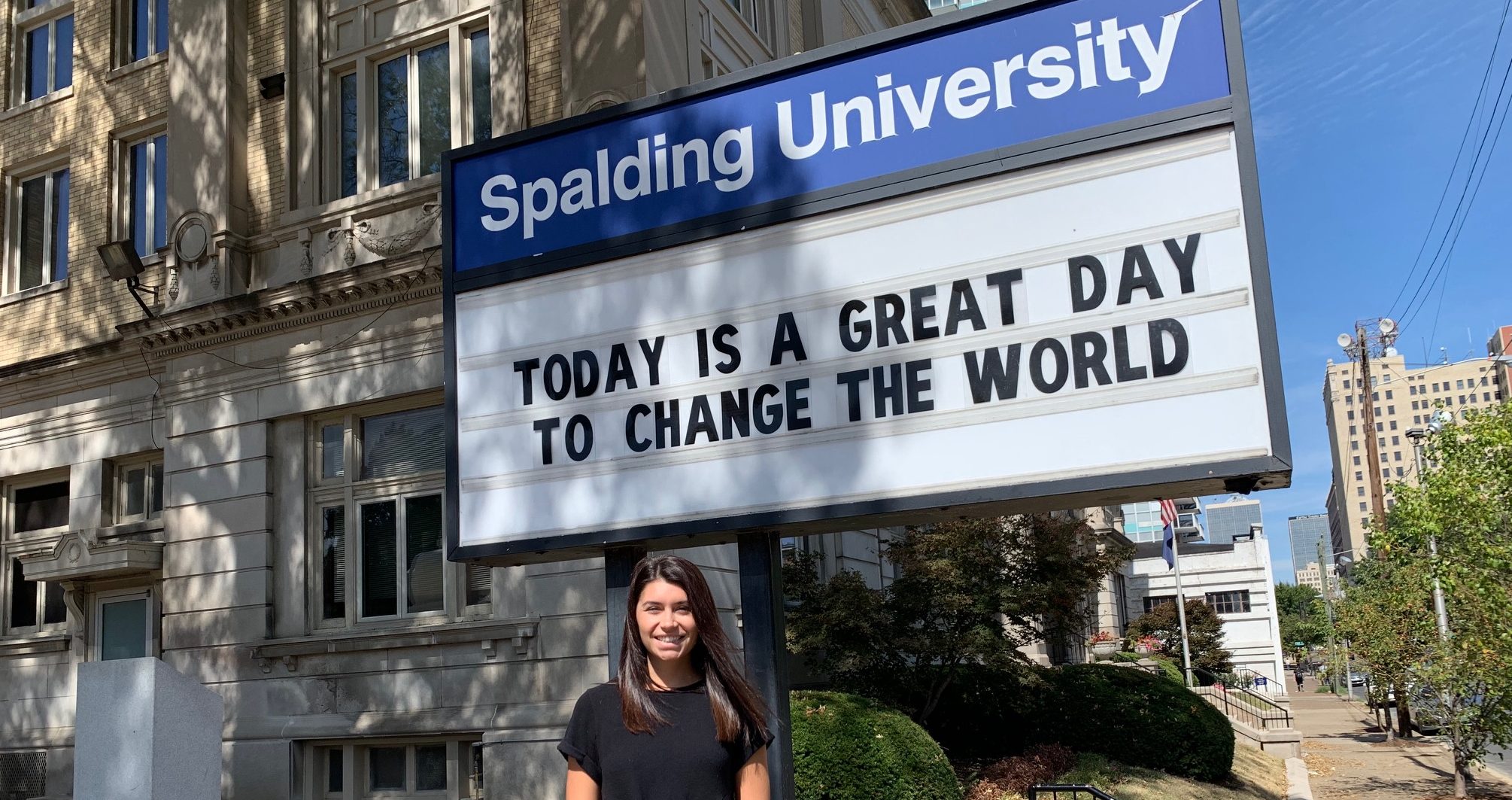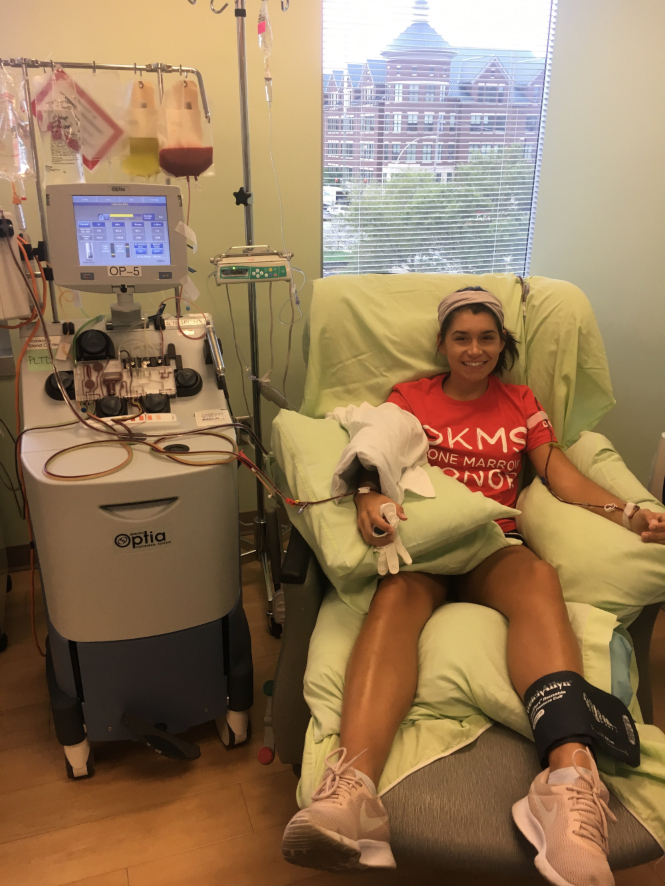
Five years ago as a college freshman, Miranda Wray attended a student activities fair – the kind of event that occurs every day on university campuses across the country. She walked around checking out tables and booths for information, including a table promoting bone marrow and blood stem cell donations.
Without thinking much of it and figuring nothing would ever come of it, Wray said agreed to register as a potential stem cell donor. After providing a quick cheek swab, Wray left and didn’t think about it again. It wasn’t long until she completely forgot that she’d even signed up.
As it turns out, a half-decade later, that afterthought of an afternoon put Wray in position to save a person’s life.
This May, Wray, who is now a second-year graduate student in Spalding’s Auerbach School of Occupational Therapy, was contacted seemingly out of the blue by the donation service, DKMS, and informed that the sample she’d given five years earlier was a perfect match for an anonymous young woman with leukemia who was in need of a transplant.
At first, Wray didn’t remember that she’d ever registered to be a donor, and it took her a while to process it all.
“I was like, ‘Wow, what is this?'” she said.
Wray followed up with a long phone call with DKMS, which carefully explained the process to her and left her time to make a decision on if she wanted to move forward.
“I knew I wanted to do it, but I’d never even given blood before or anything like that,” she said. “So I was nervous. But (DKMS coordinators) were amazing, and there was no way I wasn’t going to do it.”
Wray was eager to participate, but making a stem cell donation is no simple task. It was a four-month process, with an arduous final week.
Wray doesn’t like needles, but she had to have her blood drawn five times over the course of several months. She said she nearly passed out the first couple times. Then, in the week leading up to the donation, she received 10 injections in order to boost her stem-cell production. The injections made Wray feel like she had the flu, but they worked. She entered the donation day with stem cell levels triple their normal amount.
Finally, early last month after undergoing a full physical, Wray traveled to a medical facility to complete the donation, called peripheral blood stem cell collection. The method required Wray to lay still in a chair for six hours with a tube in each arm while her entire blood supply was cycled five times. The blood exited through one arm and was sent to a machine, where millions of stem cells were separated out and collected. Then, the blood reentered her body through the other arm.
On the day of the donation, Wray so nervous that she needed about an hour before the donation began to calm down and get her heart rate down. But she never had second thoughts, and the donation was successfully collected.
“To be a perfect match with a stranger is so rare, so I just thought it was really awesome,” she said. “I knew there was a living, breathing person somewhere out in the world who needed it. If I didn’t do this, she eventually could have passed away.”
DKMS operates on a system of strict donor-recipient confidentiality and anonymity. Wray doesn’t know the name of the woman who received her stem cells and has been given almost no information about her. But it’s possible that if the transplant ends up successful and both parties agree to it, that they could meet in a year.
Wray hopes to meet the woman someday and said she has thought a lot about what a potential meeting might be like.
“I would definitely cry a lot,” Wray said with a laugh. “Just knowing that that person maybe could build a new healthy body with my cells is the most rewarding feeling I think you could ever have.”
Wray said Spalding’s occupational therapy faculty has been fully supportive during her donation process and excused her absences she needed to miss class.
Coincidentally, DKMS’s first contact with Wray came about a week after Dr. Laura Stimler gave a lecture in her pediatrics class about blood cancers and the work of occupational therapists in oncology settings.
Wray said Stimler lectured about the exact same transplant process in which Wray ended up participating, and Wray said that her Spalding coursework had helped inform her as she moved ahead in the process.
“I was inspired to hear that Miranda was going to be a stem cell donor,” Stimler said. “Her choice to step up and help someone with complex needs is consistent with the generous spirit among our ASOT students. Miranda put her busy life on hold to give a stranger a second chance at life. This is one of the most authentic demonstrations of compassion that I have observed while teaching at Spalding.”
Stimler, who spent most of her clinical career working in pediatric oncology rehabilitation, said that in practice, the focus is primarily on the stem-cell transplant recipient, not the donor. However, Stimler said, “Miranda’s journey reminded us to consider the perspectives of all individuals involved in the transplant process.”
Stimler added that she was thrilled to hear that the class at Spalding had helped her recognize some of the complex terminology and diagnoses that came up during her donation experience.
“Miranda’s story is inspiring,” Stimler said. “We are proud to have her in ASOT.”

Miranda Wray spent several hours connected to a machine while her stem cells were collected for donation.
In another coincidence, Wray gave the donation during September, which is Blood Cancer Awareness Month.
Now she hopes that sharing her story will inspire others to register to become stem cell or bone marrow donors.
“It’s so crazy and so rare that you may get the chance to give someone a second chance at life,” she said. “I don’t know anyone else who’s ever had the chance to do this and ever matched with someone who needed a life-saving procedure like that. It was definitely one of the coolest days of my life.”